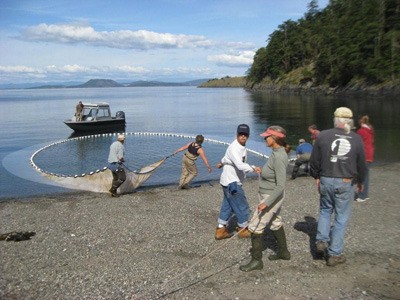The longest-running study of Salish Sea salmon food webs celebrates five years of discoveries on Jan. 12 at Lopez Center for Community and the Arts, with barbecued salmon and Lopez Island Vineyards wine, savories from Vita’s, special musical offerings, an exhibit and sale of original fish drawings by island artist Julia Loyd and a slideshow reporting on the health of our salmon. Admission is free.
When Lopez-based conservation laboratory Kwiáht and local volunteers began seining south end bays six years ago, scientists did not even know that juvenile chinook and coho salmon stop to feed in the San Juan Islands on their way to the sea. Kwiáht has now developed a model describing how visiting salmon respond to changes in the variety and abundance of prey they find here each summer, based on stomach contents collected from more than 2,500 fish.
Thanks to a dedicated corps of local volunteers, including “master lavagers” with extensive training in safely handling juvenile salmon and collecting gut contents, Kwiáht has been able to process 500 juvenile chinook a year at a cost of less than $15 per fish, and a survival rate of more than 99 percent. According to Kwiáht Director Russel Barsh, that is barely a tenth of the cost of comparable government and university studies, and is the reason that Kwiáht’s salmon monitoring station on Lopez is sustainable without large government grants.
Kwiáht’s data show that juvenile chinook mainly subsist on young pencil-sized Sandlance (also called “candlefish”) but prefer very small herring if available, probably because herring contain more calorie-rich oils. Herring spawning in the San Juan Islands declined 50 years ago and never fully recovered. Herring spawned in Mud Bay, McKaye Harbor, Fisherman Bay and elsewhere around Lopez. Seabirds nesting on the south coast of Lopez also historically relied chiefly on herring, and the herring decline is believed to be one of the reasons why marbled murrelets are close to extinction.
Herring spawn in April in shallow vegetated bays, spraying thick gobs of eggs on eelgrass or seaweeds.
“Even non-native seaweeds such as sargassum are being used successfully by herring,” Barsh says.
Seabirds feast on the freshly deposited eggs. Boat traffic and poor water quality also affect egg survival. Barsh says that critical role of herring in salmon and seabird diets is one reason why Lopez should be concerned about shipping more coal and oil through the islands.
“We modeled fuel spills from collisions around south and southeast Lopez, and they would foul nesting areas or spawning areas or both within a day,” says Barsh.
Another important discovery of the study has been that insects can make up as much as one-third of the diet of migrating juvenile chinook in late summer. Swarming insects such as midges, ants and wasps are most likely to be found in salmon stomachs. “Even grasshoppers, dragonflies and moths have been found,” Barsh adds.
Wetlands and fields near Lopez shorelines are sources



